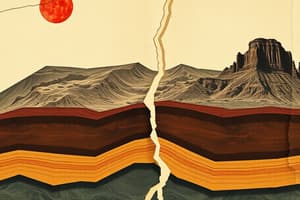Podcast
Questions and Answers
What geological feature is primarily formed at divergent boundaries?
What geological feature is primarily formed at divergent boundaries?
- Subduction zones
- Trench systems
- Mid-ocean ridges (correct)
- Mountain ranges
Which type of boundary is characterized by one oceanic plate subducting beneath another?
Which type of boundary is characterized by one oceanic plate subducting beneath another?
- Oceanic-Oceanic boundary (correct)
- Oceanic-Continental boundary
- Continental-Continental boundary
- Divergent boundary
What type of geological activity is most associated with convergent boundaries?
What type of geological activity is most associated with convergent boundaries?
- Formation of undersea canyons
- Creation of new oceanic crust
- Volcanic activity and mountain formation (correct)
- Rifting of continental plates
Which example correctly represents a transform boundary?
Which example correctly represents a transform boundary?
Which process occurs at a divergent boundary?
Which process occurs at a divergent boundary?
What is a common consequence of plate boundary interactions?
What is a common consequence of plate boundary interactions?
What type of boundary involves the collision and crumpling of continental plates?
What type of boundary involves the collision and crumpling of continental plates?
Which of the following describes the movement at transform boundaries?
Which of the following describes the movement at transform boundaries?
Flashcards are hidden until you start studying
Study Notes
Plate Tectonics and Plate Boundaries
- Plate tectonics is a theory explaining Earth's surface is divided into large and small plates, contributing to geological activity like earthquakes, volcanism, and mountain building.
- Plate boundaries are the lines where lithospheric plates meet, with interactions creating various geological phenomena.
Types of Plate Boundaries
Divergent Boundaries
- Occur when two tectonic plates move apart, creating tension.
- New crust forms as magma rises from the mantle and solidifies, also known as constructive boundaries.
- Mid-ocean ridges and continental rift valleys are formed through divergence.
- Example: Mid-Atlantic Ridge, where the Eurasian and North American plates are moving apart.
Convergent Boundaries
- Form when two plates move toward each other, resulting in three types:
- Oceanic-Continental Boundary: Oceanic plate subducts beneath continental plate, causing volcanic activity and mountain formation.
- Oceanic-Oceanic Boundary: One oceanic plate subducts under another, resulting in island volcanic chains parallel to trenches.
- Continental-Continental Boundary: Plates collide, causing compression and crumpling, leading to mountain ranges.
- Example: Himalayas formed by the collision of the Indian and Eurasian plates.
Transform Boundaries
- Occur when two tectonic plates slide past one another, also known as strike-slip faults.
- Movement results in splitting rocks along the boundary, forming features like undersea canyons or linear fault valleys.
- Example: San Andreas Fault in California, where the Pacific Plate and North American Plate slide past each other.
Impact of Plate Boundaries
- Different boundary types lead to distinct geological features and processes.
- Areas near plate boundaries are more susceptible to earthquakes, volcanic activity, and mountain formation.
Summary of Key Concepts
- Divergent boundaries create new crust as plates separate (e.g., Mid-Atlantic Ridge).
- Convergent boundaries involve plates colliding, resulting in subduction or mountain formation.
- Transform boundaries involve lateral movement of plates, leading to faults such as the San Andreas Fault.
Activities and Key Terms
- Understanding the movement direction of plates assists in identifying boundary types:
- Divergent: Plates move apart.
- Convergent: Plates move together.
- Transform: Plates slide past each other.
- Key processes: Subduction (downward bending of oceanic plates) and compression (crumpling of continental plates).
Plate Tectonics Overview
- Earth's surface is divided into large and small tectonic plates, influencing geological activities like earthquakes, volcanism, and mountain building.
- Plate boundaries mark the intersection between lithospheric plates, where various geological phenomena arise from interactions.
Types of Plate Boundaries
Divergent Boundaries
- Plates move apart, leading to tension and the creation of new crust.
- Magma from the mantle rises and solidifies at these boundaries, classified as constructive.
- Features include mid-ocean ridges and continental rift valleys.
- Example: The Mid-Atlantic Ridge, formed by the divergence of the Eurasian and North American plates.
Convergent Boundaries
- Plates move toward one another, resulting in three scenarios:
- Oceanic-Continental Boundary: The oceanic plate subducts beneath the continental plate, causing volcanic activity and mountain formation.
- Oceanic-Oceanic Boundary: One oceanic plate subducts under another, forming island volcanic chains parallel to ocean trenches.
- Continental-Continental Boundary: Collision leads to significant compression and the formation of mountain ranges.
- Example: The Himalayas, created by the collision of the Indian and Eurasian plates.
Transform Boundaries
- Plates slide past one another, producing strike-slip faults.
- Movement results in features like undersea canyons and linear fault valleys.
- Example: The San Andreas Fault in California, where the Pacific Plate and North American Plate interact.
Impact of Plate Boundaries
- Unique geological features and processes emerge from different boundary types.
- Regions near plate boundaries experience heightened risks of earthquakes, volcanic eruptions, and mountain formation.
Summary of Key Concepts
- Divergent boundaries contribute to new crust formation (e.g., Mid-Atlantic Ridge).
- Convergent boundaries involve plate collisions that can lead to subduction or mountain range development.
- Transform boundaries facilitate lateral movement resulting in faults like the San Andreas Fault.
Activities and Key Terms
- Direction of plate movement helps identify boundary types:
- Divergent: Plates separate.
- Convergent: Plates collide.
- Transform: Plates slide laterally.
- Key processes include subduction (downward movement of oceanic plates) and compression (crumpling of continental plates).
Studying That Suits You
Use AI to generate personalized quizzes and flashcards to suit your learning preferences.




